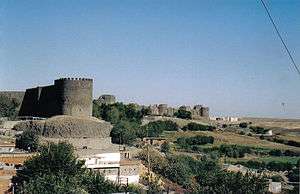Grumbates
| Grumbates | |
|---|---|
| Allegiance | Chionitae |
| Rank | King |
| Battles/wars | Siege of Amida in 359 CE |
Grumbates or Krumbates was a king of the Chionitae, probably of the Kidarites tribe, an ancient nomadic tribe of Transoxiana.
Etymology
The exact spelling and origin of his name is not fully known. Possible origins include Kurumpat (from Old Turkic *Qurum-pat, "ruling prince";[1]
[2] Old Turkic pat, "chieftain", either directly borrowed from Iranian pat, "ruler"[3] or evolved from Old Turkic baş, "head, leader"[4]). Qurum (from Old Turkic qurum, "rule, leadership, administration")[3][5][6] in the form of Krum is attested to in the royal Bulgar princes lines as well as in the Greek traditions as a designation of Bulgar Khans.[2][6] It has been suggested that Krumbates could also be composed of Iranian -bat, from Iranian pat, "ruler"; cf. Persian pād, "master".[3][6]
Attacks on the Sasanian Empire
The Kidarite king Grumbates mentioned by Ammianus Marcellinus was a cause of much concern to the Persians. Between 353 AD and 358 CE, the Xionites under Grumbates attacked in the eastern frontiers of Shapur II's empire along with other nomad tribes. After a prolonged struggle they were forced to conclude a peace, and their king Grumbates accompanied Shapur II in the war against the Romans.
Alliance with Shapur II against the Romans

Grumbates thus participated in the Siege of Amida in 359 CE as an ally of Shapur II.[7][8] His participation to the Sasanian campaign in the Eastern Caspian lands are described by Ammianus Marcellinus, who was inside the fortress of Amida at the time:[9]
"We saw below us the whole circuit of the lands filled with innumerable troops with the king (Shapur II) leading the way, glittering in splendid attire. Close by him on the left went Grumbates, king of the Chionitae, a man of moderate strength, it is true, and with shrivelled limbs, but of a certain greatness of mind and distinguished by the glory of many victories."
The son of Grumbates, while inspecting the defences of Amida, was shot and killed with an arrow shot by the city garrison.[11] Ammianus described how the Grumbates, outraged at his son's death, demanded revenge from the Romans: he compares the death to that of Patroclus at Troy. The Sassanids began the attack with siege towers and attempted to take the city hastily, but were largely unsuccessful. Unable to gain a quick victory, Shapur II had to commit to capturing Amida in order to appease his ally Grumbates.
And so, at the first dawn of day, Grumbates, king of the Chionitae, wishing to render courageous service to his lord, boldly advanced to the walls with a band of active attendants; but a skilful observer caught sight of him as soon as he chanced to come within range of his weapon, and discharging a ballista, pierced both cuirass and breast of Grumbates' son, a youth just come to manhood, who was riding at his father's side and was conspicuous among his companions for his height and his handsome person.
— Ammianus Marcellinus, 19.1
References
- ↑ Kim, Hyun Jin (18 April 2013). The Huns, Rome and the Birth of Europe. Cambridge University Press. p. 37. ISBN 978-1-107-00906-6.
- 1 2 Roemer, Hans Robert; Scharlipp, Wolfgang-Ekkehard (2000). Philologiae Turcicae fundamenta. T. 3, Philologiae et historiae Turcicae fundamenta / ed. Louis Bazin ; György Hazai. History of the Turkic peoples in the pre-Islamic period. Franciscum Steiner. p. 273. ISBN 978-3-87997-283-8.
- 1 2 3 Byzantinoslavica. Academia. 1973.
- ↑ “baş” in Nişanyan Dictionary
- ↑ Materialia Turcica. Studienverlag Brockmeyer. 1984. p. 25.
- 1 2 3 Kommission für die Altertumskunde Mittel- und Nordeuropas (1985). Untersuchungen zu Handel und Verkehr der vor- und frühgeschichtlichen Zeit in Mittel- und Nordeuropa: Der Handel der Karolinger- und Wikingerzeit. Vandenhoeck & Ruprecht. p. 74. ISBN 978-3-525-82441-2.
- ↑ Ammianus Marcellinus (1982). Res Gestae. Cambridge MA: Harvard University Press. pp. 18.8.2.
- ↑ Sassanian Iran- economy, society, arts and crafts, N.N.Chegini and A.V. Nikitin, History of Civilizations of Central Asia: The crossroads of civilizations, (UNESCO, 1996), 38.
- ↑ History of Civilizations of Central Asia, Ahmad Hasan Dani, B. A. Litvinsky, Unesco p.38 sq
- ↑ Ammianus Marcellinus, Rerum Gestarum 18.6.22.
- ↑ Ammianus Marcellinus. Res Gestae. pp. 19.1.7.
Sources
- Turks in Transoxiana, Richard N. Frye
- Richard N. Frye, Turks in Transoxiana